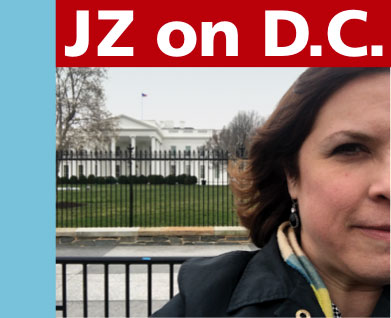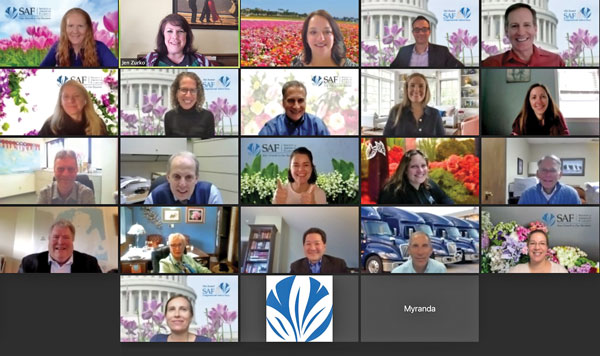6/1/2021
A Virtual CAD
Jennifer Zurko

As we continue with what I’m calling “The Age of Zoom,” the Society of American Florists’ Congressional Action Days (CAD) was the latest event that temporarily moved to a virtual platform for its 41st event. It was scaled down to accommodate those suffering from Zoom fatigue with a mix of speakers and meetings with legislators.
When CAD is in person, most delegations meet with all of the representatives from their respective states. But since that’s not realistic in a virtual capacity, SAF scheduled a handful of meetings that were tailored toward the policy makers who are on committees that directly impact floral growers and businesses.
Although connecting with a representative or their aides through Teams is simple enough (most government employees use Teams instead of Zoom because of security concerns), it doesn’t mean it was easy. Some attendees report that a couple of the people they were meeting with were walking around or driving in the car. They didn’t have their full attention like you normally do in a face-to-face meeting. And some didn’t even show their faces, so attendees had to explain the issues to a black screen with two initials.
But “it was better than nothing,” admitted Dave Armellini, one of the CAD attendees. Everyone agreed that meeting with your elected officials is better in person and it was missed. Attendees will appreciate having CAD in person that much more when it’s time for the 42nd event next year.
 One of the key highlights was when Dr. Joe Bischoff, who works for Cornerstone Government Affairs and is SAF’s senior lobbyist, moderated a panel between Mike Cuzzi and Chris Hodgson. Both now work with Joe at Cornerstone, but they have quite extensive government relations experience. Mike is the former political director for President Obama and served on President Biden’s campaign in New Hampshire. Chris is the former director of legislative affairs for Vice President Pence and worked for Congressman Steve Scalise (R-LA).
One of the key highlights was when Dr. Joe Bischoff, who works for Cornerstone Government Affairs and is SAF’s senior lobbyist, moderated a panel between Mike Cuzzi and Chris Hodgson. Both now work with Joe at Cornerstone, but they have quite extensive government relations experience. Mike is the former political director for President Obama and served on President Biden’s campaign in New Hampshire. Chris is the former director of legislative affairs for Vice President Pence and worked for Congressman Steve Scalise (R-LA).
Joe pointed out that climate change, along with climate justice and equity issues, are a primary focus for the Biden
administration.
“It’s nothing like we’ve seen in any previous Democratic administration,” he said.
For the short-term, the Biden administration will continue to focus on COVID pandemic relief and vaccine distribution, and negotiations for the American Jobs Plan, what many are calling “the infrastructure bill.” Addressing climate change issues is a large part of the Biden plan and Mike said Democrats are taking a broader approach on their thinking of what infrastructure entails.
“It’s not just roads and bridges, but broadband and green energy,” said Mike, who admitted that the administration isn’t going to let this moment pass—he speculates that much of Biden’s infrastructure plan will be passed through reconciliation. “They’re not going to wait for the Republicans to come around.”
Joe asked Chris if he thinks Republicans will earn back the majority in the House or the Senate in the next midterm election in 2022. Republicans made some gains in 2020 and they think they can take a few more House seats in 2022, said Chris. History has shown that the party who’s in the White House tends to lose seats in the next midterm election. However, if you look at the Senate seats that will be up for grabs in 2022, it doesn’t look good for the Republicans. There will be a lot of high-profile Republican senators set to retire, so it will be an uphill battle to retain those seats for the party, Chris said.
But regardless of which party is in power, there’s a lot more bi-partisan partnership than you see on the news. And both of the major parties struggle with their extreme wings, who tend to pander to their base, which Mike feels “is corrosive.” But there’s usually room to meet in the middle and Chris said he thinks the Biden administration will continue to work with people across the aisle.
“Sometimes you’re not always on the same page, but that’s okay,” said Joe. “You can still have those candid conversations.”
As for advice on approaching your elected officials on the Hill, Chris said, “Representatives often don’t hear enough from their constituents. Never underestimate the strength of your priorities.”
“Business folks have a unique ability to be strong advocates,” said Mike. “You’re in a good position because you come from a non-partisan place.” —JZ
A Quick Bit About WOTUS
EPA Administrator Michael Regan was asked during a hearing about potential actions concerning the Waters of the United States rule. Mr. Regan responded that they don’t have any intention of going back to the original Obama rule verbatim, but did say they didn’t agree with everything in the Trump administration’s version. AmericanHort says we can expect any potential action to fall somewhere in between the last two versions of the rule.—JZ
AmericanHort Supports Trucking Bill
AmericanHort lent its support to a bill known as the DRIVE Safe Act (H.R. 1745, S.659) as one medium-term solution to the truck driver shortage problem.
The bipartisan bill would enable 18 to 20-year-old apprentices—who’ve obtained their Commercial Driver’s Licenses—to drive trucks in interstate commerce. It would amend the current minimum age requirement for interstate drivers, which was promulgated decades ago, to allow these qualified drivers to operate in interstate commerce once they’ve completed several apprenticeship program requirements centered around safety.
The trucking industry has faced significant headwinds in recent years—from retirements, increased regulatory burdens and the lifestyle involved not appealing to a new generation. According to the American Trucking Associations (ATA), the trucking industry is currently facing a shortage of more than 60,000 qualified drivers, coupled with a projected need to hire 1.1 million new drivers over the next decade to keep up with increasing freight demand and workforce retirements.
AmericanHort and 117 other organizations sent a support letter to leadership of both the Senate Committee on Commerce, Science and Transportation, and the House Transportation and Infrastructure Committee last week.
—Tal Coley, Director of Government Affairs, AmericanHort
Givers & Takers—Reapportionment Data Imminent
Reapportionment, the redistribution of Congressional seats to states that occurs every 10 years, is determined by numbers from the U.S. Census Bureau. The Bureau released their long-awaited numbers in April and there were some surprises. Texas gained two seats (three were projected) and Florida gained one seat (two were projected). Colorado, Montana, North Carolina and Oregon all gained a seat. Rhode Island held firm to its congressional seats, while Minnesota and Alabama did the same. States losing seats were California, Illinois, Michigan, New York, Ohio, Pennsylvania and West Virginia.
More interesting factoids:
• New York lost a seat by a margin of just 89 people!
• Florida has now gained in every reapportionment since the 1950s, going from just eight seats in the 1950s to 28 in 2022. It’s now the third largest state for electoral votes in the country behind California and Texas.
• West Virginia saw the most population decline among the states since 2010 and now has just two congressional seats. It held six seats in the 1960s.
Things will get really interesting in September when additional Census data will be released allowing states to redraw congressional boundary lines before the 2022 election. Expect the “gerrymandering” term to be used frequently in public discourse.
—Source: AmericanHort’s Capitol Wire newsletter
News, views, commentary and event coverage about the policies and legislation that directly affect our industry. Share your thoughts, opinions and news with me: jzurko@ballpublishing.com.